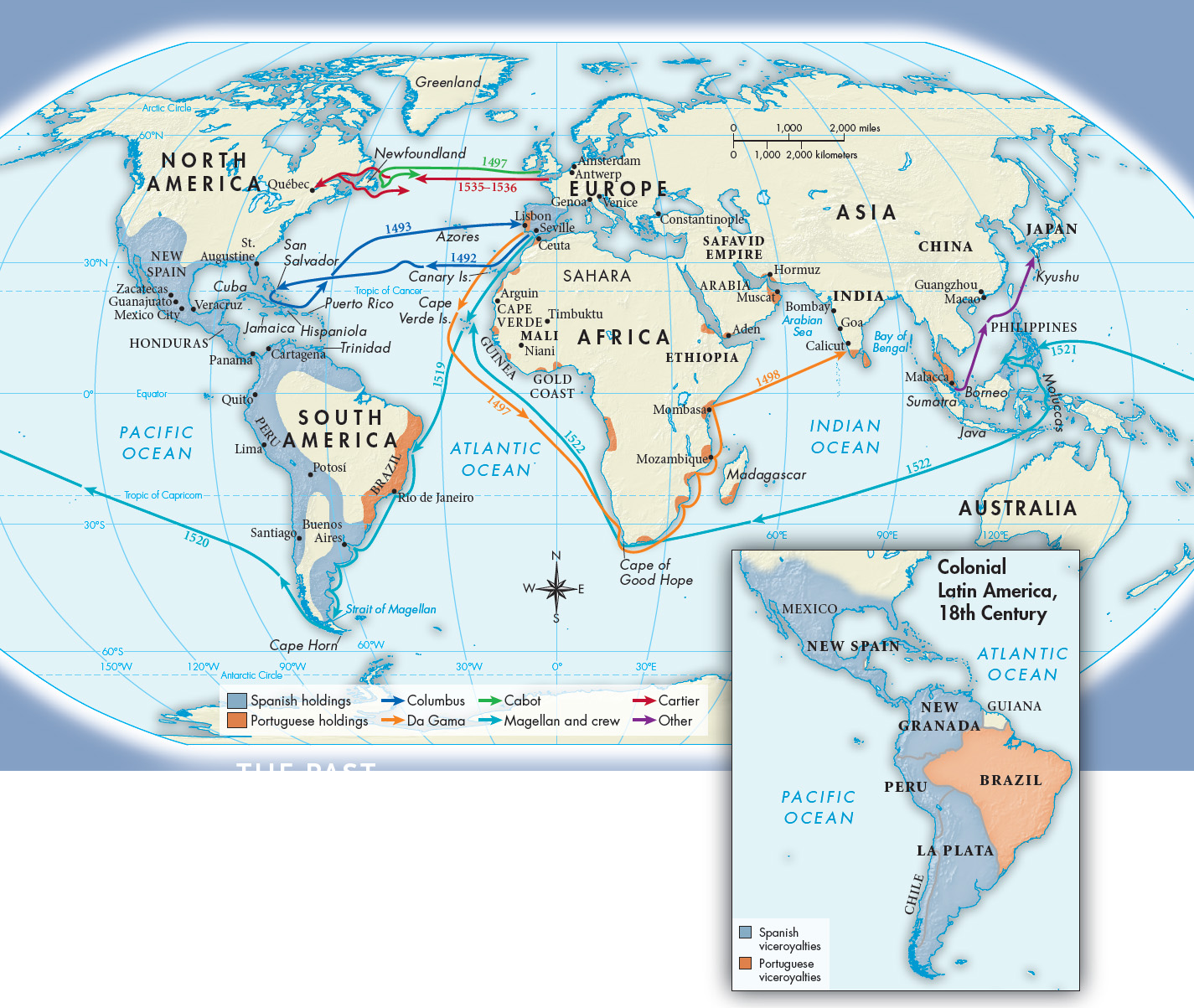A History of Western Society: Printed Page 435
A History of Western Society, Value Edition: Printed Page 447
The Portuguese Overseas Empire
For centuries Portugal was a small, poor nation on the margins of European life whose principal activities were fishing and subsistence farming. It would have been hard for a European to predict Portugal’s phenomenal success overseas after 1450. Yet Portugal had a long history of seafaring and navigation. Blocked from access to western Europe by Spain, the Portuguese turned to the Atlantic and North Africa, whose waters they knew better than other Europeans. Nature favored the Portuguese: winds blowing along their coast offered passage to Africa, its Atlantic islands, and, ultimately, Brazil.
In the early phases of Portuguese exploration, Prince Henry (1394–1460), a younger son of the king, played a leading role. A nineteenth-century scholar dubbed Henry “the Navigator” because of his support for the study of geography and navigation and for the annual expeditions he sponsored down the western coast of Africa. Although he never personally participated in voyages of exploration, Henry’s involvement ensured that Portugal did not abandon the effort despite early disappointments.
The objectives of Portuguese exploration policy included military glory; the conversion of Muslims; and a quest to find gold, slaves, and an overseas route to the spice markets of India. Portugal’s conquest of Ceuta, an Arab city in northern Morocco, in 1415 marked the beginning of European overseas expansion. In the 1420s, under Henry’s direction, the Portuguese began to settle the Atlantic islands of Madeira (ca. 1420) and the Azores (1427). In 1443 they founded their first African commercial settlement at Arguin in North Africa. By the time of Henry’s death in 1460, his support for exploration was vindicated by thriving sugar plantations on the Atlantic islands, the first arrival of enslaved Africans in Portugal (see page 450), and new access to African gold.
The Portuguese next established trading posts and forts on the gold-rich Guinea coast and penetrated into the African continent all the way to Timbuktu (Map 14.2). By 1500 Portugal controlled the flow of African gold to Europe. The golden century of Portuguese prosperity had begun.

MAPPING THE PAST
ANALYZING THE MAP Consider the routes and dates of the voyages shown. How might have the successes of the earlier voyages contributed to the later expeditions? Which voyage had the most impact and why?
CONNECTIONS How would you compare Spanish and Portuguese New World holdings in the sixteenth century with those of the eighteenth century? How would you explain the differences and continuities over time?
The Portuguese then pushed farther south down the west coast of Africa. In 1487 Bartholomew Diaz rounded the Cape of Good Hope at the southern tip, but storms and a threatened mutiny forced him to turn back. A decade later Vasco da Gama succeeded in rounding the Cape while commanding a fleet of four ships in search of a sea route to India. With the help of an Indian guide, da Gama reached the port of Calicut in India. Overcoming local hostility, he returned to Lisbon loaded with spices and samples of Indian cloth. He had failed to forge any trading alliances with local powers, and Portuguese arrogance ensured the future hostility of Muslim merchants who dominated the trading system. Nonetheless, da Gama proved the possibility of lucrative trade with the East via the Cape route. Thereafter, a Portuguese convoy set out for passage around the Cape every March.
Lisbon became the entrance port for Asian goods into Europe, but this was not accomplished without a fight. Muslim-controlled port city-states had long controlled the rich spice trade of the Indian Ocean, and they did not surrender their dominance willingly. From 1500 to 1511 the Portuguese used a combination of bombardment and diplomatic treaties to establish trading forts at Calicut, Malacca, Hormuz, and Goa, thereby laying the foundation for Portuguese imperialism in the sixteenth and seventeenth centuries. (See “Primary Source 14.1: A Portuguese Traveler Describes Swahili City-States of East Africa.”)
In March 1493, between the voyages of Diaz and da Gama, Spanish ships under a triumphant Genoese mariner named Christopher Columbus (1451–1506), in the service of the Spanish crown, entered Lisbon harbor. Spain also had begun the quest for an empire.